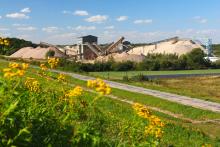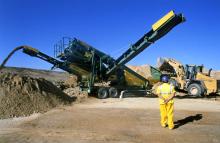
The rivers and canals of Europe may provide an answer to the problems of moving aggregates greater distances. Paul Howard talks to GSM's Xavier Lascaux about developments in France
With calls for 'sustainable development' and concerns about global warming now a constant refrain, the transportation of aggregates is coming under ever greater scrutiny. This is partly a result of the nature of the materials themselves. Aggregates are, after all, both heavy and bulky, making their movement from one spot to another a costly business both financially, and perhaps more importantly, for the environment. This is especially the case for the vast majority of aggregates that are freighted by road - over 90% in most Western European countries - where fuel consumption and greenhouse gas emissions are considerably higher than alternative transport methods.
According to
Figures from the VNF (Voies Navigables de France - the state body charged with maintaining and developing France's navigable rivers and canals) show that transport on waterways consumes three to four times less fuel and emits up to four times fewer greenhouse warming gases than road and rail.
The issue is compounded by the fact that as quarrying permissions become ever more stringently monitored, the distance between production and consumption is growing. Another aggravating factor is the continuing concentration of the economic activity that drives the consumption of aggregates into a handful of large, urban centres, often in areas where consumption has long since out-stripped local supply.
It seems entirely logical then that the industry and public bodies should combine their efforts in looking for alternatives to this quasi-monopoly of aggregates transport currently enjoyed by road. It also seems entirely logical that waterways should be considered as one of the most promising of these alternatives.
Of course, there are very clear, geographical limitations as to how far such an approach can be taken. Large areas exist without navigable rivers or canal networks. Yet where such networks do exist, history indicates the opportunities in moving aggregates for construction afforded by the inherent weight-bearing efficiency of waterborne transport. The stones at the UK's Stonehenge made most of their remarkable 380km journey from south-west Wales to Wiltshire by water - some 4,000 years before the invention of the internal combustion engine.
It is in France, though, that the government and the aggregates industry have decided to make a collective effort to increase the proportion of modern-day aggregates carried on the country's waterways. First, the VNF signed a partnership agreement with the industry trade body
The Canal Seine-Nord
According to Francois Bordry, the completion of the Canal Seine-Nord project will mark the beginning of a new era in waterborne freight transport. The canal is not new, however. A link from the Seine river basin to the network of rivers and waterways in northern France and thence into the Benelux countries and the Rhine already exists. The problem at the moment, from the point of view of aggregates producers and consumers, is that it is not big enough. "You can only use boats up to 350tonnes on parts of it," explained Lascaux. "It is now being extended to accommodate barges of more than 1,000tonnes capacity." Some sources say this capacity will in fact go as far 5,000tonnes. It should be noted that one 5,000tonnes barge can move the same amount of aggregates as 250 lorries or 125 railway wagons. The project is due to be completed in 2014, and includes not just creating access for bigger boats but also creating the freight depots and links with road and rail networks necessary for them to thrive. The aim is to have increased by 2020 total traffic on the canal four-fold relative to the level of 2000."GSM is the first to take this further with what is hoped to be the first of several specific undertakings between private companies and the VNF," explained Lascaux. "We want to show our shared desire to develop the network." According to Mr Lascaux, the fact that the desire is shared - and demonstrated in such a public way - is important. "The VNF manages the network. They're a public body and they don't want to spend taxpayers money if they don't have an undertaking that we won't do our bit to make traffic grow. At the same time, we won't invest in the cost of the infrastructure we require if we are not reassured that we'll get the support we need from them in terms of maintenance, for example." The partnership is about more than just waterway maintenance, however. "There are lots of hurdles to be overcome before water transport can step in to accommodate these developments," Lascaux added. "There are hurdles in terms of money, yes, but also in terms of infrastructure. We need to create multi-modal 'platforms' where aggregates can be delivered, unloaded, sorted, stored and then put onto trucks (or possibly trains) for the final part of their journey.
"These therefore need a lot of room as well as access to the road or rail networks and of course it takes time for them to become profitable; for the traffic flow and volume of materials to become sufficient. We also need to develop sites for loading of aggregates onto waterways in the first place, and this raises similar issues for re-distribution once they've arrived." Another issue is liasing with port management authorities. "River docks are considered public property in France and are then leased out to private companies," he pointed out. "This could create capacity issues if they're not up to speed with plans to develop the use of waterways for aggregates." Then there is the apparent shortage of boats or barges. "We need more boats, so this is a way of saying to those who are involved in running barge fleets that they can have confidence that there will be a market for them. We must also look at the training of operators in what the aggregates industry needs from barge owners." With such significant up-front investment of both time and money required, the inevitable question arises:
'is it worth it?' What potential does waterborne transport offer in the face of competition from road and rail? Currently, in France, UNICEM's latest available figures record 15million tonnes of aggregates being transported via waterways (not including sea transport). This represents just under 4% of the total, although Lascaux suggests a figure closer to 7%. Whichever figure is more accurate, the intended growth in water transport will be starting from a very low base.
There has been considerable growth, however. According to Francois Bordry, VNF President, waterway transport of freight nationally in France has grown by 40% in the past 10 years. This is one of the reasons why in 2007 the French government included it as one of three priority investment areas in its bid to reduce the country's reliance on road freight. Political will was underlined by a promise of investment to renew not just the waterway network, but also access to it. This was also the promise of a series of initiatives to encourage river transport.
It should also be remembered that this picture of small scale waterborne freight transport is for the whole of France, including the majority of the country's surface area which has no access to navigable waterways. Even where waterways exist France's infrastructure is not as well endowed as that of some of its neighbours: it has fewer than 2,000km open to the largest modern barges, while the Benelux countries and Germany between them have 8,500km.
The picture is also very different - and more optimistic - in the country's better-equipped navigable river basins, notably the Seine. Here, UNICEM suggests as much as 5million tonnes of aggregates are transported by water - a third of the national total. Once again Lascaux trumps these figures, saying as much as 25% of Ile de France aggregates are transported by boat and barge, giving a total tonnage of around 10million tonnes. What's more, the VNF says 33.8% (measured by tonnes/km) of construction material in the Seine basin is transported by waterways. Coal - another bulk material - is almost exclusively moved by water.
"The Ile de France is the region in France where waterborne aggregates transport is the most developed," Lascaux confirmed. "Why? Because it has the best network of waterways - the Seine, and its tributaries the Marne and the Oise - as well as canals, and has the largest market in France for aggregates, therefore the demand is greatest. With 90% of current aggregates consumption being made up of alluviums the product is already near to water so it is 'normal' to use water for transport. The result is the customers for these products have also developed on or near water - in Paris most of the major concrete and ready mixed concrete producers have sites on the Seine." So far the aggregates traffic supplying these consumers has been made up of relatively local sources. The task now is to make the infrastructure stand up to moving materials from different areas that are further away. "Currently the Ile de France only produces around 50% of the material it consumes, and this proportion is shrinking. This means it will be necessary to 'import' more aggregates from further away, and the idea is to encourage this transport by water," said Lascaux.
In practical terms this means using two potential sources of raw material outside the Ile de France region: the 'Arc Nord' - from Boulogne into Belgium - and marine aggregates from the Seine basin in the English Channel. With these two sources in mind, and with the planned development of the Canal Seine-Nord (see box), Lascaux said it is possible for the proportion of aggregates moved by water in the Ile de France to grow further - by another quarter to more than 30% of the total, in fact. "It's difficult to set dates but it could be done very rapidly if all went according to potential. It's a question of identifying the hurdles and the steps to take to overcome them and then getting on with it. Everybody from the government and public bodies like the VNF to private companies such as ourselves has an interest in developing alternative means of transport. There is a strong desire to replace our reliance on road transport which is more polluting, nosier and causes a whole range of other nuisances." Getting on with it is the key, of course, but at least the Ile de France experience suggests that where a reasonable infrastructure already exists, as it does in many parts of Europe, the rewards can be worthwhile.









